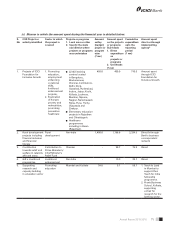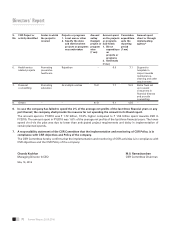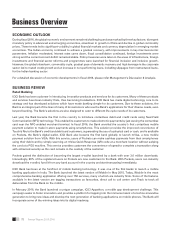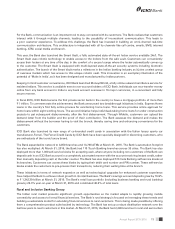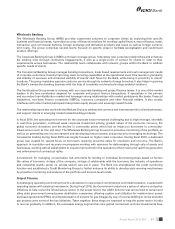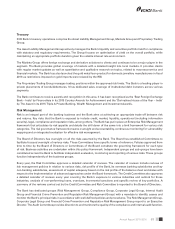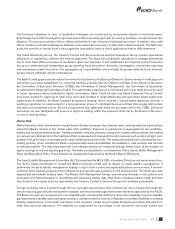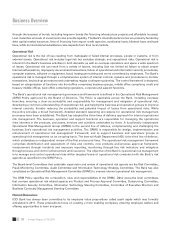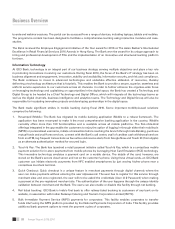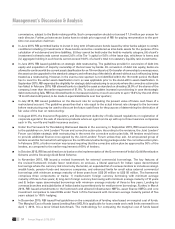ICICI Bank 2016 Annual Report Download - page 86
Download and view the complete annual report
Please find page 86 of the 2016 ICICI Bank annual report below. You can navigate through the pages in the report by either clicking on the pages listed below, or by using the keyword search tool below to find specific information within the annual report.
84
Business Overview
Annual Report 2015-2016
The Compliance and Internal Audit Groups have administrative reporting to an Executive Director. These groups are
independent of all business operations and coordinate with representatives of the business units to implement the Bank’s
risk-management methodologies.
Credit Risk
Credit risk entails the risk of loss that may occur from any party’s failure to abide by the terms and conditions of any
nancial contract, principally the failure to make required payments to the Bank. All credit risk related aspects are
governed by a Credit and Recovery policy, approved by the Bank’s Board of Directors. The Credit and Recovery policy
outlines the type of products that can be offered, customer categories, targeted customer prole and the credit approval
process and limits. The Bank measures, monitors and manages credit risk at an individual borrower level and at the
portfolio level for non-retail borrowers. The credit risk for retail borrowers is being managed at portfolio level. The Bank’s
structured and standardised credit approval process includes a well-established procedure of comprehensive appraisal.
It has also established a Country Risk Management Policy, which addresses the identication, measurement, monitoring
and reporting of country risk.
The credit risk associated with any corporate nancing proposal is assessed based on an analysis of the borrower and the
industry in which the borrower operates. The Bank has developed internal credit rating methodologies for rating obligors.
In case of facilities backed by third-party comforts such as corporate guarantees, letters of comfort, put option or shortfall
undertaking, the rating of the borrower for such facilities is anchored to that of the comfort provider. The rating serves
as a key input in the approval as well as post-approval credit processes. The Bank has a framework for conducting asset
reviews. The risk based review framework outlines the review schedule wherein the frequency of asset review is higher
for cases with higher exposure and/or lower credit ratings. These reviews are conducted periodically (quarterly, half-
yearly or yearly) based on the review schedule. Relevant industry knowledge is constantly updated through eld visits
and interactions with clients, sector regulators and industry experts.
The appraisal and execution of project nance transactions involves a detailed evaluation of technical, commercial,
nancial, marketing and management factors and the sponsor’s nancial strength and experience. The Bank identies
the project risks, mitigating factors and residual risks associated with the project. As a part of its due diligence, the Bank
appoints consultants, including technical advisors, business analysts, legal counsel and insurance consultants, whenever
necessary. Risk mitigating factors in project nance loans include creation of debt service reserves and channelling
project revenues through a trust and retention account. The Bank’s project nance loans are generally fully secured, and
have full recourse to the borrower. In some cases, the Bank also takes additional credit comforts such as corporate or
personal guarantees from one or more sponsors of the project or a pledge of the sponsors’ equity holding in the project
company.
The Bank has rened and strengthened its framework for managing concentration risk, including limits/ thresholds with
respect to single borrower and group exposure.
In case of retail loans, sourcing and approval have been segregated to maintain independence. The Credit Risk Management
Group has oversight on the credit risk issues for retail assets including vetting of all credit policies and operating notes
proposed for approval by the Board of Directors or forums authorised by the Board. The Credit Risk Management Group
is also involved in portfolio monitoring for all retail assets and suggesting and implementing policy changes.
The Retail Credit and Policy Group is an independent unit focusing on policy formulation and portfolio tracking and
monitoring. This group also includes the Credit Administration Unit that services various retail business units for
credit underwriting. In addition, there is also a Business Intelligence Unit to provide support for analytics, score card
development and database management. The credit ofcers evaluate retail credit proposals on the basis of the product
policy vetted by the Credit Risk Management Group and approved by the Committee of Executive Directors. These
criteria vary across product segments but typically include factors like the borrower’s income, the loan-to-value ratio
and demographic parameters. Reports from credit bureaus also serve as an important input in making credit decisions.



